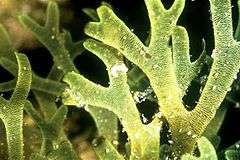Dictyotales
| Dictyotales | |
|---|---|
 | |
| Dictyota dichotoma | |
| Scientific classification | |
| Kingdom: | Chromista |
| Phylum: | Ochrophyta |
| Class: | Phaeophyceae |
| Order: | Dictyotales Bory de Saint-Vincent |
| Families | |
| |
Dictyotales is a large order in the brown algae (class Phaeophyceae).[1] Members of this order generally prefer warmer waters than other brown algae. One genus in this order is calcareous, Padina, the only calcareous member of this phylum.[2]
Dictyota dominates 70% of the benthos biomass in the Florida Keys reef tract.[3] The successful spread of this alga is due in part to its ability to asexually reproduce from fragments created by "biotic and abiotic disturbances".[3]
References
- ↑ Guiry, MD; GM Guiry (2006). "AlgaeBase version 4.2". World-wide electronic publication, National University of Ireland, Galway. Retrieved 2006-11-22.
- ↑ Lee, RE (1999). Phycology (Third ed.). Cambridge: Cambridge University Press. ISBN 978-0-521-63883-8.
- 1 2 Beach, Kevin S; Walters, Linda J (2000). "Dictyota bloom in Florida Keys National Marine Sanctuary: Fragments and fouling". In: Hallock and French (eds). Diving for Science...2000. Proceedings of the 20th Annual Scientific Diving Symposium. Retrieved 2011-01-07.
Further reading
- Gauna, Cecilia; Caceres, Eduardo; Parodi, Elisa (December 2013). "Temporal variations of vegetative features, sex ratios and reproductive phenology in a Dictyota dichotoma (Dictyotales, Phaeophyceae) population of Argentina". Helgoland Marine Research. 64 (4): 721–732. doi:10.1007/s10152-013-0357-0.
- Lozano-Orozco, Jorge G.; Sentíes, Abel; Díaz-Larrea, Jhoana; Pedroche, Francisco F.; de Clerck, Olivier (1 January 2014). "The occurrence of Dictyota canariensis (Dictyotales, Phaeophyceae) in the Gulf of Mexico". Botanica Marina. 57 (5): 359–365. doi:10.1515/bot-2013-0111.
- Vieira, Christophe; D'hondt, Sofie; De Clerck, Olivier; Payri, Claude E. (December 2014). "Toward an inordinate fondness for stars, beetles and Lobophora? Species diversity of the genus Lobophora (Dictyotales, Phaeophyceae) in New Caledonia". Journal of Phycology. 50 (6): 1101–19. doi:10.1111/jpy.12243. PMID 26988791.
| Wikispecies has information related to Dictyotales |
This article is issued from
Wikipedia.
The text is licensed under Creative Commons - Attribution - Sharealike.
Additional terms may apply for the media files.